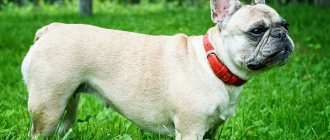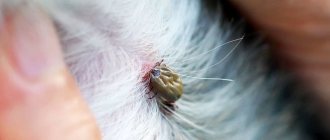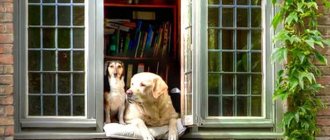The appearance of a pet in the house is associated with certain costs, because a puppy and an adult dog must be provided with all the necessary accessories.
Mandatory pieces of equipment include a collar, which is used for walking the animal, during its training, and even not at exhibitions.
Looking at photos of dog collars, you can visually evaluate the huge range of products offered by domestic and foreign manufacturers.
To choose the right functional and practical accessory, you need to study the necessary information and have a whole range of special knowledge.
Types of dog collars
Currently, dog owners have access to a variety of equipment for their pets. The photo shows all the variety of dog collars. For daily walks, you can choose options based on the requirements for the material of manufacture.
If desired, you can find leather, rubber, nylon models. The price of dog collars will depend not only on the material used, but also on the size.
It also depends on the purpose for which it is purchased. Depending on the intended use, specialists distinguish several categories:
- Exhibition;
- Behavior-correcting devices;
- Decorative.
Special purpose
According to their intended purpose, pet ammunition is divided into several functional categories, these include:
- decorative accessories for exhibitions and shows;
- sports collars for shows and competitions;
- everyday models for walking and walking;
- service ammunition used in hunting.
The strict dog collars required for training are not used for all breeds and are selected according to the individual parameters of the pet.
Show collars
A distinctive feature of this type is its unobtrusive appearance. Collars are created in the form of a metal chain or cord made of nylon or leather.
- If you purchase a metal version, then you should pay attention to the quality of the steel - preferably a minimum amount of chemical impurities so as not to irritate your pet’s skin.
- The links must be welded. This will avoid possible ruptures due to strong jerks of the animal. In addition, good polishing of welding areas is important.
- Poor processing results in jagged edges that can cause abrasions on the leather.
Important: The length of the chain should be 5-6 cm greater than the circumference of the dog’s neck.
Comfort for you and your dog
Before choosing a specific accessory design, you should also think about how convenient it will be to use. To do this, you need to understand a few cynological tricks:
Note!
DIY ottoman: TOP-190 photos of the best diagrams and drawings. Do-it-yourself master class with a full description of the stages of work
- Do-it-yourself easel - varieties, drawings with dimensions for creating with your own hands. Step-by-step instructions for beginners
How to Write a Screenplay: Tips and Best Practices for Writing a Screenplay. Step-by-step master classes for beginners with detailed descriptions of the stages
- To make it easier to control the dog, the collar should be attached immediately behind the ears; the lower it slides during use, the more difficult it is for the owner;
- If your pet is pulling, you should under no circumstances lead him with a wide collar or, worse, a harness;
- If there are problems with control (the animal pulls, breaks from the leash, zoo aggression is possible), a noose collar for dogs is ideal;
- A good control should not be too soft on your pet's neck, or too wide or too narrow. (Thin choke chains are used only for canine adjustments or preparation for the ring).
Compression controls (choke, semi-choke with clamp) can be used on animals older than 8 months.
Means for correcting behavior
The following designs are available in this category:
- Strict;
- Noose;
- Electric collar;
- Halti.
Rules for using the “planer”
Parfors for a dog is a method of training it. It may be needed, for example, when a pet does not obey during a walk and pulls on the leash. You cannot use a strict collar for a long time, much less constantly.
To accustom your pet to the “grinder”, at first you should wear it for a short time at home. Training in such equipment should last no more than an hour. If you wear the product for a long time, it may irritate your dog's skin.
During a walk, if the animal tries to rush forward, you should briefly pull it by the “strach”. This will stop the pet and make it obey its owner. This way the dachshund will understand that he has done something inappropriate, and over time he will learn to behave correctly.
But you shouldn’t wear a “strogach” for every walk, so that the animal does not develop an association of pain and irritation associated with the street. In the worst case scenario, the dog may become fearful.
After training, it is worth removing the “stringer” from your pet to protect it from accidental injury. There are cases where dogs left unattended in such collars for long periods of time have seriously injured themselves, resulting in death.
If the dachshund has learned to be obedient, you can part with the “handler.” If everything is done correctly, the pet will obey the owner even in a regular soft collar.
Dog handlers emphasize that the use of a “stringer” is only a temporary measure, and it is necessary to teach an animal obedience even without the use of such a product.
Strict collar
Its other name is parfors. This type differs from all others by the presence of spikes on the inside. Thanks to their presence, during sudden jerks the pet will experience discomfort and be more attentive to the owner’s demands.
When using a strict collar for a dog, you should pay close attention to choosing the size: when using it, you need to place the links as close to the dog’s ears as possible.
Important: The spikes of strict collars can vary in length. The longer the coat, the longer they should be. For example, parfors with long spikes are suitable for breeds such as: Caucasian Shepherd Dog, Malamute, Newfoundland. “Wheelers” with short spikes can be suitable for Staffordshire terriers, Great Danes, and boxers.
Wicker options
You can weave a dog collar from a number of available materials. For this you can use:
- Fabric scraps;
- Old belts;
- Clothesline or nylon rope.
In addition to the above, you will need to take care of the clasp. This can be a flexiblex or a noose-type mechanism or a semi-noose type mechanism. For a noose, 2 identical metal rings are required, for a semi noose, 3 rings and a chain.
Note!
- Cake decorating: TOP-170 photos of the best ideas for decorating a cake at home + instructions for beginners with simple patterns
- How to make a house out of cardboard: 140 best photos of children's crafts with your own hands + step-by-step manufacturing instructions with simple diagrams
- DIY rose lamp - step-by-step instructions for creating a lamp with your own hands + original design ideas with photo reviews
Noose
The collar, with its self-explanatory name, looks like a self-tightening loop that tightens around the animal’s neck during sudden movements. You can find a noose made of leather, metal or rope.
Important: This type is especially dangerous for the dog. Even the leather version can cause serious harm. Therefore, it should be used in exceptional cases and for a short time.
The simplest option
The easiest way to make a collar is from a belt, because the main components are already ready. However, a dog's sparse neck can rival a human's waist. All you need to do is cut the belt to the required size and make new holes. For ease of use, it is also advisable to leave clamps for the free end and make a patch for the ring, to which the leash will eventually cling.
If the edge of the belt cut is not neat, it is advisable to decorate it. This can be done by treating it with metal rivets or stitching it with leather. The easiest way is to cover it with colored tape and carefully touch it with a lighter. If the belt is made of not very high-quality leather substitute, it can be strengthened. To do this, you need to glue a thick fabric tape on the inside with waterproof (shoe) glue. This trick will not only extend the life of the collar, but also make it more comfortable to wear.
Electric collar
A modern option that allows you to control behavior at a distance using electrical impulses. The degree of impact, as well as the range, varies.
An electronic collar for a dog allows you not only to correct reactions, but will also help you find your pet if necessary by an audio signal.
Important: Electric collars help owners maintain control over their dog when they let it off leash. Therefore, they are convenient to use for training.
But among dog handlers there is no clear opinion about the benefits of these models. Some experts argue that the animal can become fearful and depressed from constant fear of electric shock.
What materials will you need?
Before starting work, you should look at pictures of a dog collar and choose a reference. That is, an approximate version of the product that should be obtained as a result. In some cases, you can get by with old things that have long gone out of use. You will need:
- Worn bags;
- Belts and sashes;
- Items made of dense fabrics (leather, velor, denim, bolognese, fiberglass, tapestry);
- Accessories and decorations (beads, stones, sequins, rivets);
- Reflective tape (fabric);
- Thick or thin nylon clothesline;
- Black or colored electrical tape (preferably matching the color of the future accessory);
- Strong threads, gypsy needle or awl;
- Glue “moment” or its equivalent;
- Indelible marker;
- Metal ring (diameter should be equal to the width of the collar).
Before you make a dog collar with your own hands, make sure you have all the necessary components. It is not necessary to look for all the listed items, but to make a complete and functional product you must have:
- Material for the base (canvas, fabric for a collar or rope for a noose or braided version);
- Accessories for fastening (buckle from an old belt, or fastex from an old backpack or waist bag).
- Sewing supplies.
You can also decorate the product with embroidery, applique, stripes, etc. At the same time, decoration can carry a certain functionality. For example, you can embroider the pet's name or the owner's phone number on the collar so that if the animal is lost, you can easily contact him.
For those who like to walk in the evenings, a reflective tape will be an excellent decoration, which will help you see the dog better in the dark.
Halti
Another name is a halter. The design consists of two loops fastened together with rigid straps.
- When used, one loop is placed over the dog's face and the second loop is placed around the dog's neck.
- When the leash is pulled, the head automatically turns back, preventing rapid forward movement.
Important: the leash is attached to the lower part of the loop located on the animal’s muzzle. Although the model looks like a muzzle, it does not perform its function.
Whatever the choice, collars in this category are intended solely for regulating behavior and cannot be used every day.
Dog handlers especially emphasize this point: Daily use makes the dog insensitive to the effects. Due to this, the animal gradually begins to ignore both the collar itself and the owner’s commands.
How to put a collar on a dog
After purchase, you can begin direct use. Correct donning will make subsequent use easier and will have a beneficial effect on the final result.
Sequencing
After the operation, the animal is dressed by the veterinarian, and in all other cases by the owner himself. To do this, just follow the following algorithm:
- Prepare the product and secure the pet in place - alone or with an assistant.
- Place the cone around your neck and secure with clasps.
- Check the seal with your finger. It should fit freely between the neck and the accessory.
- Praise your pet and treat him to a treat.
If the situation does not require urgent use, take care of training. This will make subsequent wearing easier.
How to accustom an animal to a cone
Show your pet an unfamiliar object and let him sniff it. Once you are sure there is no fear, put it on and distract your dog with food or play. Take the product off and on until the dog gets used to it. Usually the adaptation period takes 2-3 days.
What to do if the dog takes off the cone?
If adaptation is delayed, then there is a high probability that an error was made with the size or material. Try choosing a model with a tighter fit - or replace noisy plastic with fabric.
Decorative collars
The name itself suggests that models in this category can only be used as a kind of decoration.
- In production, any material that meets the design is used: Leather, suede, nylon.
- Collars can be decorated with rhinestones, beads, and beads as decorative elements.
Important: Decorative options should not be used to control behavior. Suitable for dogs of small breeds, such as: Shih Tzu, Toy Terrier, Italian Greyhound.
Soft with clasp
This textile collar is available with or without a semi-automatic clasp. Thanks to the buckle, you can adjust the width of the neckline.
The product is convenient because it can be adjusted to the changing parameters of a growing dog. A special fastener (fastex) will eliminate the need to cut new holes as the pet grows older. When the puppy grows up, the collar can be changed to another.
Everyday collars
Walking options are most popular among dog breeders.
They are of the same type in the manner of manufacture: The model consists of a strap, a half-ring for a leash and a clasp that allows you to tightly clasp the animal’s neck.
- The main requirement is wear resistance, reliability and quality of rivets.
- The most commonly used materials are canvas, leather or nylon.
Leather products
Leather collars look extremely aesthetically pleasing; they are chosen by owners who attach importance to the appearance of their pet. High-quality leather products have double or triple stitching, thanks to which they do not wear out for a long time.
When choosing a collar, you should look at its inner surface. There should be no threads or knots, these are signs of marriage. Poor-quality firmware can injure the animal’s skin.
The only significant disadvantage of such collars for dachshunds is their high cost. If the product is of high quality, it can cost several thousand rubles.
Leather
The most common type of collar.
- Due to the quality of the material, it causes the least harm to the dog’s fur and skin.
- It is distinguished by external aesthetics, high wear resistance and reliability.
- Can be used both when working with large breeds and small dogs.
Important: Leather models do not tolerate moisture and heat well. Therefore, you should carefully care for it, applying special products to preserve the elasticity of the material.
Raincoat for dachshund
Representatives of this breed do not need clothing: if you walk with him for a long time and often, they develop excellent immunity, and in the future, hardening does not allow them to get sick. If you want to decorate your pet, sew him a blanket; other clothes will do harm. For example, overalls spoil your posture and disrupt your gait and are harmful to your fur.
To read: Munchkin: an exotic breed of cats with short legs
The dog will need a raincoat if you plan to go on long hikes with it or take it out into nature. In this case, it is worth using it if it rains for a long time and for many days. This will protect the animal from colds and keep its fur clean. A raincoat is sold in pet stores; it is easy to sew it yourself from waterproof fabric. If you need to insulate it, make a lining from padding polyester. You can purchase special boots and a hood to go with it.
Canvas
To make models of this type, cotton threads are used with stitching using fishing line.
- They are particularly durable, so they do not tear under heavy loads.
- But at the same time, the fur at the collar site can be wiped off.
Important: Despite their strength, the belts are susceptible to breaking. A small amount of damage is enough for them to quickly rupture completely.
Breed Features
The Dachshund was originally bred as a hunting dog. Despite her peculiar appearance, she does not look clumsy at all. On the contrary, the Dachshund has enviable strength and agility. Of course, having such short legs, she cannot develop great speed and chase the animal like a hound. But she has no equal as a burrowing dog, hunting foxes, rabbits, badgers and other animals. The dachshund is capable of not only luring them out from underground. If necessary, she can engage in combat with the beast right in the hole. This is where her sharp teeth come in handy.
However, the Dachshund is not at all an angry and aggressive dog. On the contrary, she knows how to get along with other pets and gets along well with children.
She has a sharp mind, is sociable and inquisitive, she likes to be the center of attention. At the same time, the Dachshund is an excellent protector.
She loves walks and is not afraid to go outside late at night. In case of danger, she will decisively rush to the offender and protect her owner.
Nylon
In this case, the collar material is based on nylon. There are models both in the form of a belt and in a more interesting interpretation - woven from cords.
A characteristic feature is the variety of colors. In addition, wicker structures can withstand loads of up to 290 kg, which makes them indispensable when working with large breeds of dogs.
Important: When purchasing, pay attention to the fittings. Very often, nylon versions in the form of belts are equipped with plastic fittings. This feature makes the structure extremely fragile, so it is only suitable for walking small dogs.
Due to its versatility, everyday options are convenient to use when walking dogs of any breed. You just need to choose the right size so that walking together becomes comfortable for both the pet and the owner.
At what age do puppies need a collar?
You should start putting the collar on the baby as soon as he is brought to his new home.
If you adopted a dog more than six months old and not familiar with this accessory, then you need to put it on when the pet gets used to its new home and stops being afraid.
The favorable age for starting training in equipment is 1.5-2 months.
Unusual models
In addition to the usual items, you can find unusual ammunition. One of them is a GPS collar for dogs. Its peculiarity is that with the help of satellite communications you can find out exactly where the animal is. Such collars are suitable for hunting dogs - with the help of a signal you can accurately determine the location of the four-legged hunter.
In recent years, glow-in-the-dark collars have become popular.
- For this purpose, in such cases, as a rule, LED strips are placed on the straps.
- But options are possible in which a phosphor coating is applied to reflect light.
- The undoubted benefit of such models is that when walking in the dark, the dog will be visible from afar.
If there is a road for vehicles next to the walking route, this will help protect your pet from collisions with cars.
Types of collars for dogs
Dog neck cones are made from different materials. Each of them has its own advantages and disadvantages.
Fabric
The fabric construction is hypoallergenic, waterproof and reusable. Among the disadvantages are a poor viewing angle and low strength. The accessory wrinkles easily, so if the dog really wants to, he can quickly get rid of it.
Plastic
A product made of transparent plastic is a classic option with a minimal price. Its main problems are its short service life and loud noise when in contact with other surfaces.
Inflatable
It differs not in material, but in shape. Resembles a life preserver, providing a very good viewing angle. Suitable for animals with short legs and neck.
Rules for choosing a collar for a dog
Experienced dog handlers advise following a number of rules when choosing a collar for your pet.
- Taking into account individual characteristics. It is important not only to pay attention to the dog’s temperament, but also to its age. Many novice dog owners buy collars based on their taste. But for puppies, especially small breeds, a harness is more suitable. It does not injure either the developing bones or the fine fur.
- The material of construction is of great importance. Leather or canvas straps must have smooth stitching and no defects. Metal chains and links at the soldering points are without jagged edges. Otherwise, not only will the effectiveness of the collar be lost and its service life will be reduced. You can seriously damage your pet's skin.
- Accessories. When purchasing, carefully examine the fittings. If possible, give preference to products made of good metal. Poor quality attachment points or leash rings can quickly break.
Reliability, functionality and safety
The primary question in the process of making ammunition for an animal is: how to sew a collar for a dog with your own hands so that it is not only beautiful, but also durable. In this case, it is important to focus on such parameters as the size, speed, character of the pet and, importantly, preferred walking areas.
So, for small dogs that are not prone to running away, a decorative collar-ornament is suitable; for pets who pull, it should be tight, well fixed with a reliable clasp. For medium-sized and giants, it is desirable to have good quality ammunition that will not let you down in any situation.
It should be taken into account that if the dog often goes to the beach and loves to swim, a leather collar will not suit him (it stretches and deteriorates from frequent exposure to water), and a metal clasp is not advisable, since after a couple of swims it will become rusty or oxidized. When the dog often walks on sand or clay soil, the accessory on the neck will be constantly smeared, grains of sand will get clogged into the porous fabric.
If your dog is friendly and likes to play with his friends, you should think about the safety of both parties. Dogs love to bite each other's necks when playing, so the ideal option would be a wide collar made of very dense material, while avoiding decorations in the form of thorns and glued-on stones.
Firstly, such details can damage your four-legged friend, and secondly, a playmate can accidentally swallow part of the decor and get health problems.











